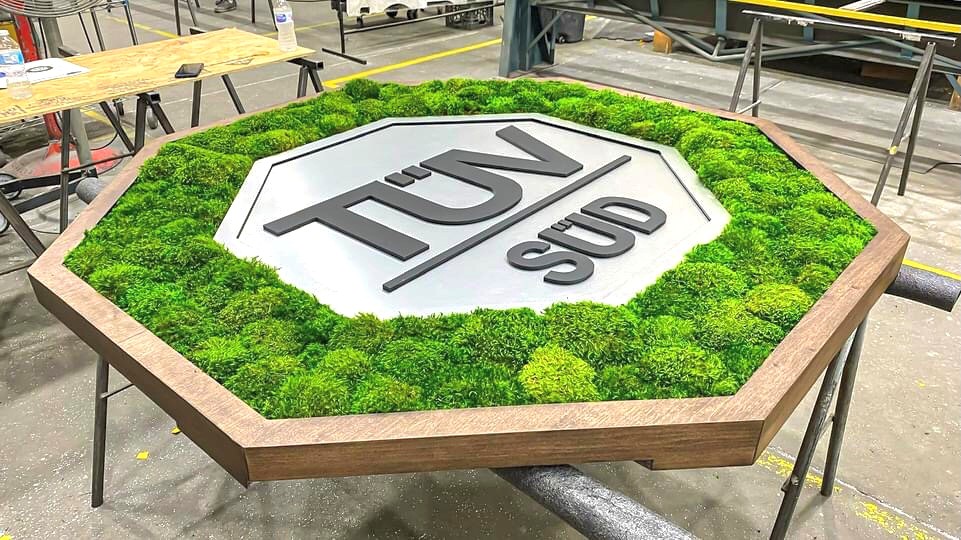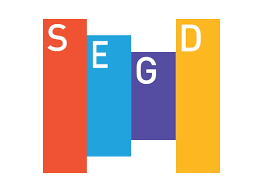While we don’t have a handy Magic 8 ball able to reliably predict the future, it hasn’t stopped us from making some educated guesses about next year’s signage industry trends. They include:
- Minimalism in design. We’ll continue to see signs focused on clean, crisp images that evoke elegance.
- Improved sustainability. As more companies embrace ESG (environmental, social, and governance) policies, they’re incorporating eco-friendly initiatives into their buildings, including signage construction, materials, and power.
One of Metro’s recent clients, TÜV SÜD—a Germany-based company offering safety, security, and sustainability solutions—opted to use an innovative wall sign for its U.S. headquarters, for example. Metro’s partner, CityScapes, recommended the preserved moss material featured in the sign.
Initially, the clients asked to use real wood around the border, but the production team sourced a wood laminate stained Dark Walnut. This more cost-effective approach offered the texture of real wood and evoked the warm feeling the clients hoped to achieve.
- Inclusive visuals. Process-based inclusive design is related to accessibility. It’s not, however, an outcome but a methodology for approaching design. Think of it as a process for creating designs usable by diverse groups of people.
- Bold backgrounds. Monochrome effects are also trending for 2022. When combined with muted colors, geometric shapes create fun visual effects and provide the perfect background for user-friendly text.
Another recent Metro client, Evoqua Water Technologies, chose large wall graphics to reinvent the look of its office space. These vibrant, branded wall graphics have transformed a drab environment into an area that channels inspiration and hope.
- Serif fonts. Around since the 15th century, serif fonts have regained popularity, too. These fonts work well for brand promotion and evoking a specific style and tone. (Sans serif fonts also remain part of design portfolios). Typography will also prioritize legibility and readability as accessibility awareness grows.
- Supply Chain. While we’re eager to bid goodbye to the pandemic, logistics experts predict that some of the material disruptions it caused will linger into 2022. While the other trends on this list are easy to adjust to, we thought it worth diving into this challenging trend a bit more.
Supply Chain Snarls Will Continue to Affect the Signage Industry
Few industries have escaped the challenge of finding the raw materials they need to manufacture products. We’ve heard and read about shortages in chips and processors, paper goods and lumber, and many other products. And everyone’s told us to plan ahead and start our holiday shopping early.
The signage industry hasn’t escaped supply chain disruption, either. While some raw material prices, like plastics, are beginning to drop or level off, the demand and price of steel and aluminum continues to rise.
Alcoa Corp., the U.S.’s largest producer of aluminum, has struggled to source magnesium and silicon—another key ingredient for aluminum products—has also become scarce. Even sourcing inks for printing has proven challenging.
Early in the pandemic, Metro found it difficult to find acrylic, as more companies like banks, stores, healthcare centers and other organizations used it for separation panels to provide distance between people. Metro’s teams pivoted, for a while, to use aluminum composite material (ACM) instead.
As demand has leveled out for many raw materials, companies needing them for production face a different challenge. Standard materials like aluminum extrusions, acrylics, vinyls and paint tints, that used to take a few days to arrive in Metro’s workshop now take weeks or sometimes months.
Working with What You Have
With the unpredictability of material availability, sometimes Metro’s designers have needed to think outside the box—and innovative thinking has repeatedly saved the day.
Tom Dunn, Metro’s owner and VP of sales & marketing, says, “We’ve had a few clients whom we’ve talked to about using different materials either because of difficulties getting the supplies or because of rising raw material costs. However, with a little ingenuity and flexibility, our teams—and the collaborative partnerships with our clients—have helped us to identify more cost-effective workarounds.”
Companies who are on the fence about whether to move forward with signage projects should talk to us and get their projects started sooner, rather than later, so they’re not waiting longer than necessary for their signs,” he says.

